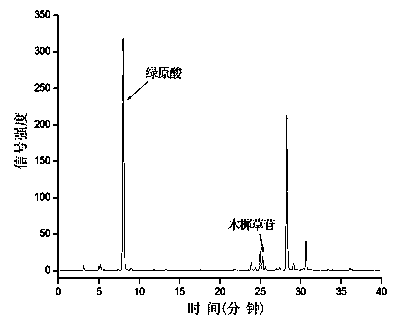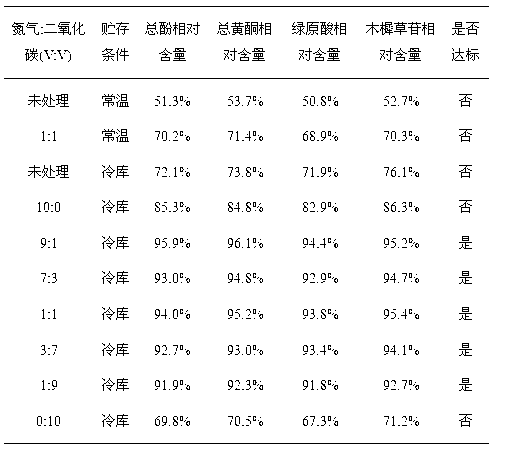Storage and fresh preservation method of honeysuckle
A storage and preservation, honeysuckle technology, applied in food preservation, food science, application and other directions, can solve the problems of honeysuckle being easy to absorb moisture, mildew or moth-eaten, less attention to content, and incapable of large-scale promotion, etc. The process is simple and the effect of avoiding damp and mildew
- Summary
- Abstract
- Description
- Claims
- Application Information
AI Technical Summary
Problems solved by technology
Method used
Image
Examples
Embodiment 1
[0038] In this example, 100 kilograms of dried honeysuckle with a water content of 8% are taken and put into a packaging bag, and a mixed gas with a volume percentage of nitrogen and carbon dioxide of 1:9 is filled into a double-layer composite packaging bag through a pipeline for controlled atmosphere , Seal the packaging bag after the modified atmosphere treatment, and store in a constant temperature refrigerator at 4°C. After 12 months, compared with the contents of chlorogenic acid, luteolin, total phenols, and total flavonoids in honeysuckle before storage, the retention rate of chlorogenic acid was 91.8%, the retention rate of luteolin was 92.7%, and the retention rate of total phenols was 91.9% %, the retention rate of total flavonoids was 92.3%.
Embodiment 2
[0040] In this example, 100 kilograms of dried honeysuckle with a water content of 6% are taken and put into a packaging bag, and a mixed gas with a volume percentage of nitrogen and carbon dioxide of 1:4 is filled into a double-layer composite packaging bag through a pipeline for controlled atmosphere , Seal the packaging bag after the modified atmosphere treatment, and store it in a constant temperature refrigerator at 2°C. After 12 months, compared with the contents of chlorogenic acid, luteolin, total phenols, and total flavonoids in honeysuckle before storage, the retention rate of chlorogenic acid was 93.2%, the retention rate of luteolin was 95.3%, and the retention rate of total phenol was 93.7%. %, the retention rate of total flavonoids was 94.1%.
Embodiment 3
[0042] In this example, 100 kilograms of dried honeysuckle with a water content of 8% are taken and put into a packaging bag, and a mixed gas with a volume percentage of nitrogen and carbon dioxide of 2:3 is filled into a double-layer composite packaging bag through a pipeline for controlled atmosphere , Seal the packaging bag after the modified atmosphere treatment, and store in a constant temperature refrigerator at 4°C. After 12 months, compared with the contents of chlorogenic acid, luteolin, total phenols, and total flavonoids in honeysuckle before storage, the retention rate of chlorogenic acid was 92.5%, the retention rate of luteolin was 94.1%, and the retention rate of total phenol was 93.5%. %, the retention rate of total flavonoids was 93.6%.
PUM
 Login to View More
Login to View More Abstract
Description
Claims
Application Information
 Login to View More
Login to View More - R&D
- Intellectual Property
- Life Sciences
- Materials
- Tech Scout
- Unparalleled Data Quality
- Higher Quality Content
- 60% Fewer Hallucinations
Browse by: Latest US Patents, China's latest patents, Technical Efficacy Thesaurus, Application Domain, Technology Topic, Popular Technical Reports.
© 2025 PatSnap. All rights reserved.Legal|Privacy policy|Modern Slavery Act Transparency Statement|Sitemap|About US| Contact US: help@patsnap.com



